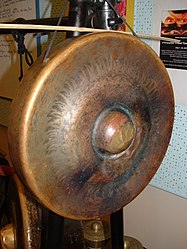Babendil
 |
|
| Percussion instrument | |
|---|---|
| Classification | Idiophone |
| Hornbostel–Sachs classification | 111.242.1 (Bell) |
| Developed | Philippines |
The babandil is a single, narrow-rimmed Philippine gong used primarily as the “timekeeper” of the Maguindanao kulintang ensemble.
The babandil usually has a diameter of roughly one foot making it larger than the largest kulintang gong and comparable to the diameter of the agung or gandingan. However, unlike the gandingan or the agong, the babendil has a sunken boss which makes the boss relatively non-functional. Because of their sunken boss, babendils are instead struck either at the flange or the rim, using either bamboo betays or a strip of rattan, producing a sharp, distinctive metallic clang and are sometimes considered “false gongs.” In fact, this distinction makes the babendil classified as a bell in the Hornbostel-Sachs classification (if it were struck at the boss, it would be considered a gong.)
Babandils are normally made out of bronze but due to the scarcity of this metal in Mindanao, most gongs, including the babendil are made out of more common metal such as brass, iron and even tin-can.
The babendil could be played while standing or when seated with the babendil hung half a foot from the floor. Proper technique requires the player to hold the babendil vertically, angled away from the body, with the gong held at the rim between their thumb and four fingers. With their thumb parallel to the rim of the gong, the players strikes the rim of the gong using their betay to play fundamental patterns that are similar to the drum pattern on the dabakan or the beat of the lower-pitched agung.
The babendil traditionally could be played by either genders. In wooden kulintang ensembles, the kagul is usually substituted for the babendil part. Among the Tausug, the Samal and the Yakan, their babendil-type instrument generally has gone into disuse (Instead, tempo is kept in check using the highest gong on the kulintangan . Solembat is term used by the Samal for the ostinato beat while the Yakan call that same beat, nulanting.) while among the Tagbanwa, the babandil is used not only to keep the rhythm of pieces but also as a song accompaniment as well.
...
Wikipedia
